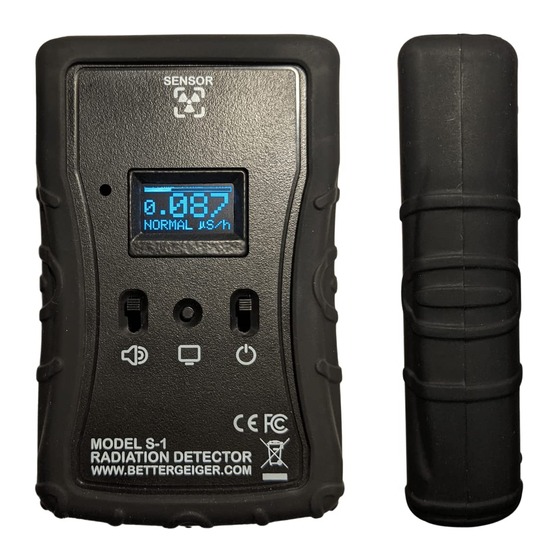
Summary of Contents for Better Geiger S-1
- Page 1 User Manual Better Geiger Radiation Detector Model S-1 Read entire manual and all warnings before use www.bettergeiger.com...
-
Page 3: Table Of Contents
Table of contents Warnings General Information Technical Specifications Basic Operation Display Modes Understanding Display Numbers General Tips Troubleshooting Raw Signal Access 10. FCC User Guide Statement 11. Declarations of Conformity... -
Page 4: Warnings
1. Warnings This device is intended to be used only for educational purposes. There is no guarantee of performance specifications, accuracy, or reliability. The detector should not be used for activities or decision-making related to health and/or safety. Any use of the device not in accordance with this user guide voids any applicable warranty. -
Page 5: General Information
X-ray, gamma, and to a limited extent beta ionizing radiation. It is not sensitive to alpha radiation, including elevated radon concentrations in air. The sensitive element inside the S-1 is a solid scintillator. X-ray/gamma radiation tends to easily penetrate the plastic enclosure of the S-1 and reach the scintillator. - Page 6 “uranium glass” items, and some naturally occurring radioactive minerals such as uranium ore. The preferred direction for measuring a localized beta emitter with the Better Geiger is towards the bottom of the detector, exactly opposite the printed symbol indicating the scintillator position.
-
Page 7: Technical Specifications
3. Technical Specifications Values are approximate and subject to change. (10 µSv/hr = 1 mrem/hr) • Dimensions without rubber protector: 73 x 26 x 118 mm (2.9 x 1.0 x 4.6 in • Weight, detector only without batteries: 120 g (4 oz) •... -
Page 8: Basic Operation
• Qualitative dose rate indications NORMAL: 0-1 µSv/hr HIGH: 1-10 µSv/hr DANGER: >10 µSv/hr • Screen update interval 1-4 s • Cumulative measured values (time, average CPM, average µSv/hr, total µSv) are calculated over the entire time period since the device was last powered on, and those values are reset to zero when the device is powered off 4. - Page 9 Care should be taken to orient the “+” and “-” ends of the batteries so that they match the “+” and “-” marked positions on the case. Alkaline or lithium batteries are preferred but the device will also work with most standard rechargeable AA batteries.
-
Page 10: Display Modes
The display mode button cycles between the six display modes (described in the following section). When the device powers on it begins in the first display mode. From the first mode, each button press changes to the next mode unless the device is in the 6 mode. -
Page 11: Understanding Display Numbers
Mode 2: Same as mode 1 but display number is mrem/hr (indicated as “mr/h” on screen) Mode 3: Same as mode 1 but display number is raw counts per minute (CPM) interaction rate before dose rate estimate is calculated. Mode 4: Larger graphical bar graph display of dose rate from 0.01 to 10,000 µSv/hr, scaled logarithmically with each decade indicated. - Page 12 Radiation dose is a unit related to the health effect on the human body of radiation. For X-rays and gammas it depends not only on the quantity of photons entering the human body but also the energy of those photons (among other factors). Higher energy photons have a larger effect on the body in terms of dose and health hazards.
- Page 13 can vary widely but 2,000-3,000 µSv per year is common. At the time of writing this document, in the US the annual whole-body limit allowed for workers exposed to radiation is 50,000 µSv. The qualitative limits displayed of “NORMAL”, “HIGH”, and “DANGER” are arbitrarily defined with thresholds of 1 µSv/hr for “HIGH”...
-
Page 14: General Tips
occur with a dose above approximately 1 Sv or 1,000,000 µSv. The acute dose at which the chance of death is around 50% is 4 Sv. 7. General Tips To measure general X-ray/gamma dose rate levels in a uniform radiation field, the detector orientation is typically not important. - Page 15 levels it will update faster, as quickly as every 1 second. Except for Mode 5, the values shown are usually averaged over the last 10 to 40 seconds, and the detector automatically attempts to balance accuracy with responsiveness. For best accuracy in Modes 1-4 it is generally best to place the detector in one place for at least 40 seconds.
-
Page 16: Troubleshooting
8. Troubleshooting There is no low battery indicator on the display. If the clicking sound coming from the speaker begins to decrease noticeably in volume, if the dose rate or count rate value seems abnormally low, if the device loses power quickly after being powered on, or if the device will not power on at all then the batteries might need to be changed. - Page 17 located near the hole next to the display. There are four contact points: Ground connection Analog dose. This is an uncalibrated analog signal from 0 to 5V outputting dose values up to ~10 µSv/hr, scaled logarithmically. User should perform calibration measurements at multiple dose levels to calibrate.
-
Page 18: Fcc User Guide Statement
11. Declarations of Conformity FCC Supplier's Declaration of Conformity 47 CFR § 2.1077 Compliance Information Product Name: Better Geiger S-1 Radiation Detector Description: Handheld portable radiation measurement deviceResponsible Party: www.bettergeiger.com This device complies with the following regulations: 47 CFR Part 15, Subpart B –... - Page 19 EMC - EN 61326-1:2013 , EN 55011:2016 Safety - IEC 61010-1:2010, EN 61010-1:2011 RoHS2 Technical Documentation- EN 63000:2018 Product Name: Better Geiger S-1 Radiation Detector Product Model Number: S-1 We, the undersigned, hereby declare that the equipment specified above conforms to the above Directives and Standards.


Need help?
Do you have a question about the S-1 and is the answer not in the manual?
Questions and answers